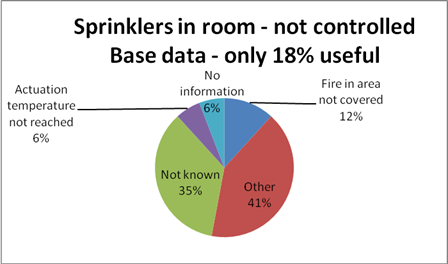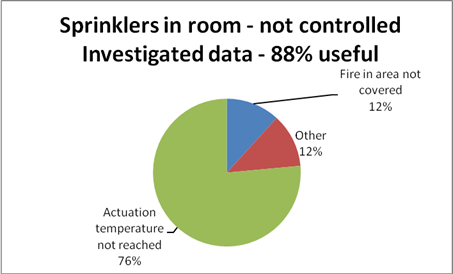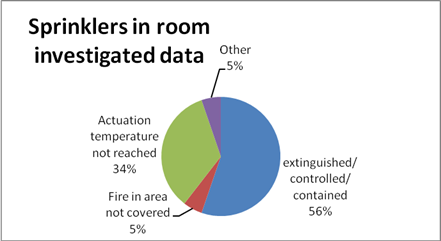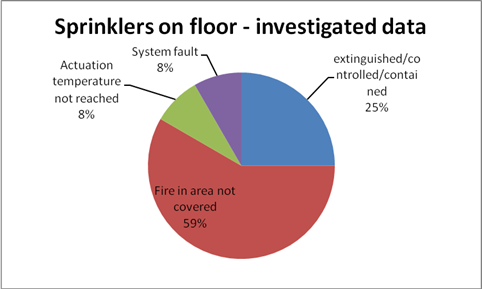Automatic Sprinkler Suppression Systems Data
by Nigel Firkins, Fire Engineer, London Fire Brigade
26 October 2012 note: This is Nigel Firkins’ discussion paper – Section 4 is an analysis of the current IRS data fields with some recommendations. Nigel says “As far as I can see I have reflected the up to date i.e. post April 2009 position”. Happy to receive any comments by email, NIGEL.FIRKINS@london-fire.gov.uk
1. Background
1.1 The Communities and Local Government(CLG) Fire Statistics, Great Britain, 2010 – 2011, www.communities.gov.uk/fire/researchandstatistics/firestatistics/firestatisticsuk, provided information about sprinkler performance, that included over 50% incomplete or “not known” data. Stakeholders, such as Fire and Rescue Authorities, Sprinkler Trade Associations and other users need reliable data about sprinkler performance so that they can make informed decisions.
1.2 Sections 3.14 and 3.15 of the CLG report indicates that in 51% of buildings where sprinklers were present in the room of origin and 55% where sprinklers were present on the same floor, it was “not known” as to whether the systems were effective. This calls into question the current system of inputting electronic fire reports as data entered incorrectly or without full knowledge can skew statistics and produce incomplete evidence on the performance and effectiveness of sprinkler systems.
1.3 The perception that such a high percentage of the data is “not known” could have a detrimental effect on sprinklers by fostering the belief that the it is difficult to measure the performance of sprinklers in real life applications.
1.4 The GB Fire Statistics data could also have an adverse effect on life safety and property protection, as the data indicates that where sprinklers were present in the room of origin they were effective in only 42% of cases , falling to 19% where sprinklers were present on the same floor. International studies [1] into sprinkler performance typically site reliability above 80% and in many cases well over 90%. It is widely accepted that sprinklers will usually control a fire and in many instances extinguish it thereby protecting life and property.
1.5 Reliability of sprinklers has two components. Operational reliability measures the probability that a system or component will operate as designed when required. Performance reliability is a measure of the adequacy of the system once activated. The current data collection does not appear to adequately measure these important criteria in the most meaningful way.
1.6 This report includes an analysis of data from the London Fire Brigade (LFB) Incident Management System (IMS) about fires in sprinklered buildings. This data is drawn from the electronic FDR1 fire report form and is presented both in its raw form (base data) and also in a refined form (investigated data), where the underlying information and circumstances have been analysed.
2. London Fire Brigade Data
Data sets from May 2011 to April 2012 were gathered from IMS and revealed the following information.
2.1 No of data entries, i.e. Fires in Sprinklered Buildings
Fires in Sprinklered Buildings |
74 |
|---|---|
Sprinklers present in room of origin |
38 |
Sprinklers present on the same floor |
35 |
Sprinklers present on a different floor |
1 |
Total |
74 |
2.1.1 Sprinklers present in room of origin:
Sprinklers present in room of origin |
38 |
|---|---|
Extinguished/controlled/contained |
21 |
Not extinguished contained/controlled |
17 |
Sprinklers in room not controlled |
Base data |
Investigated data |
|---|---|---|
Reasons: |
||
Fire in area not covered |
2 |
2 |
Other |
7 |
2 |
Not known |
6 |
0 |
Actuation temperature not reached |
1 |
13 |
No information |
1 |
0 |
Total |
17 |
17 |


2.1.2 Sprinklers present on the same floor:
Sprinklers on same floor of origin |
35 |
|---|---|
Extinguished/controlled/contained |
9 |
Not extinguished contained/controlled |
18 |
Not known |
7 |
Base data |
Investigated data |
Not known |
|
|---|---|---|---|
Sprinklers on floor not controlled |
18 |
18 |
7 |
Fire in area not covered |
16 |
16 |
5 |
Other |
1 |
0 |
|
Actuation temperature not reached |
1 |
2 |
1 |
System fault |
0 |
2 |
1 |
Total |
18 |
25 |
7 |
2.1.3 Sprinklers present on a different floor:
Only 1 entry:
Fires not extinguished contained/controlled |
1 |
|---|---|
Reason: Fire in area not covered |
1 |
3. LFB Data Analysis
3.1 Analysis of the underlying data, shows a wide variability in the way people enter information about similar events. It is clear that not all officers understand what data is required and how the information entered may be interpreted. It is also worth noting that all the necessary information is either not collated or not available on site at the time of the incident creating difficulties and inconsistencies in correct data entry.
3.2 Of the 38 incidents where sprinklers heads were present in the room of origin of the fire, on 21 occasions the fire was extinguished, contained or controlled by the actuation of the sprinkler system. On 17 occasions the sprinkler system did not actuate in the room of origin of the fire, this was due to;
- On 13 occasions the required temperature to activate the head was not reached,
- On 2 occasions the sprinkler heads were not in the vicinity of the fire, this could be linked to the statement above with regard to temperature actuation.
- On 2 occasions, 1 x system vandalised in an unoccupied/derelict building where the system did not operate and 1 x 4 heads operated in a small bin room system but the bins were not put back under the heads, the system failed but arguably there is a training need about where staff should position the bins.

This indicates more than 90% success rate and demonstrates that sprinkler systems operate only when the design temperature is reached.
3.3 Of the 35 instances that the sprinkler system was sited on the same floor of the building, on 9 occasions the actuation of the system extinguished, contained or controlled the fire. On 26 occasions the system did not actuate, this was due to;
- On 21 occasions, the fire was in an area not covered by the system.
- On 3 occasions the actuation temperature of a specific head was not reached.
- On 2 occasions there was a system fault, one of which was a fire in a sprinkler motor, the other being most likely to be where the actuation temperature of a specific head was not realised. This second incident was a fire in a boiler room, the cabling to an electrical part, extinguished by Brigade personnel with a Carbon Dioxide Extinguisher

Once again a high reliability of 92% demonstrates that sprinklers control the fire if they are in the area and the actuation temperature is reached.
4. Analysis of IMS/IRS data fields and IRS Guidance (v 2.3)
4.1 The relevant fields are contained in the Action page where “Active Systems” contains a list of different fire-fighting/safety systems. Sections 7.12 to 7.17 of the IRS guide contain the relevant guidance.
4.2 A comparison of U.K. data fields was carried out with the USA NFIRS data fields [2].
4.3 Both “Pressurisation & Smoke Ventilation” systems are included in the Active System subset, which may cause confusion as some subsequent questions are not relevant to this type of system, e.g. about extinguishment.
4.4 Data entry screens appear to lead officers to enter data if a system was present anywhere in the building, whilst the guidance document clearly indicates that only systems “in the vicinity of fire/origin of fire” need to be entered. It is at this point that much of the incorrect data is being entered as sprinkler systems located away from the fire, or at those fires that do not develop sufficiently, are being recorded as “did not operate” or did not contain/control.
4.5 Location (of Active System) entries are divided into “in room of fire, on fire floor or on different floor, once again these seem to lead officers to enter data where suppression systems were remote from the fire and not expected to operate. It may be beneficial to reconfigure this question to ask: Active system in room of origin? With the possible responses: a) Present b) Partial c) Not in area/room of origin.
4.6 The next question concerns system Operation and asks did system operate, with the three responses a) No b) Yes but did not raise alarm c) Yes and raised alarm. With the proliferation of automatic smoke detectors and alarm systems it is unclear what is the benefit of the alarm question, as it is much more likely, in most occupied buildings that the AFD system would raise alarm before the sprinklers operate. Data regarding detection and alarm appears to be fully covered in earlier sections (see guidance for Q 5.8 to 5.12).
4.7 Data is also collected about system Impact (on the fire) and asks about whether the system extinguished the fire or, contained/controlled the fire.
4.8 It should be possible to combine and re-focus the current questions regarding Operation and Impact into a single question about “System Operation” with four possible responses.
- System operated and was effective
- System operated and was not effective
- System did not operate when expected
- Fire too small to activate system
4.9 Data is currently collected about “reasons system ineffective” with a number of drop down box options. These appear to be always active and it is suggested that these fields should only become active if options b) or c) above are selected.
4.10 It may be beneficial to develop separate drop down box options for category b) failures and category c) failures. For example “System did not operate when expected” is an operational reliability issue that includes such issues as, inappropriate system, lack of maintenance etc., whilst “System operated and was not effective” is a performance reliability issue that would include issues such as, not enough agent released, agent did not reach fire. Etc.
4.11 Finally, there is a further IMS data field for “other reason system ineffective”. No guidance is offered in the IRS guide and it is suggested that if the drop down box option are more comprehensive and permit multiple selections where appropriate the additional data field may not be needed.
5. Conclusions
5.1 The way that the current data collection is structured appears to be unhelpful and creates difficulties for those inputting data.
5.2 Some of the key data is not being collected. For example the response “actuation temperature not reached/insufficient heat to actuate” is only recorded as a comment. This question is critical to a correct assessment of sprinkler performance and should be viewed as a system success.
5.3 From the LFB IMS data, it is clear that officers at fire station level either lack knowledge of the information required or lack knowledge of the use of the data. It is also apparent that the data collected in its current format is not providing the most helpful and meaningful data to end users.
5.4 Officers need clearer guidance about the completion of the online FDR1 fire report form. This should improve the quality of input so that more credible information can be obtained for the statistical data that is produced by DCLG. The data presented in the current Fire Statistics, Great Britain, 2010 – 2011 gives a misleading picture of the performance and operations of sprinkler suppression systems and the outcomes in fires in buildings where they are installed.
5.5 A few simple changes to data fields and some minor improvements in guidance should enable the collection of more accurate and complete data that is more meaningful.
6. Recommendations
5.1 I would recommend that:
- a. That recommendations are made to improve the content and structure of the electronic IMS/IRS form with the aim of ensuring that more relevant detail is entered. This should focus on and distinguish between “operational” and “performance” reliability issues.
- c. Officers who complete the online form are provided with improved instruction and guidance on completion with regard to sprinkler data and how it is used.
References
- Koffel, W., Reliability of Automatic Sprinkler Systems
 , Revised January 2006
, Revised January 2006 - Hall, J. R., U.S. Experience with sprinklers and other automatic fire extinguishing equipment, February 2010